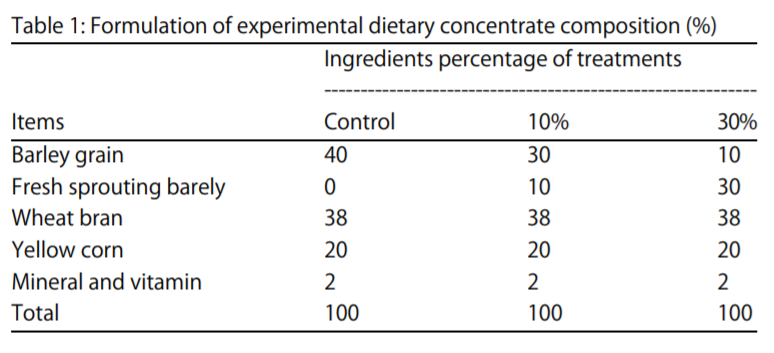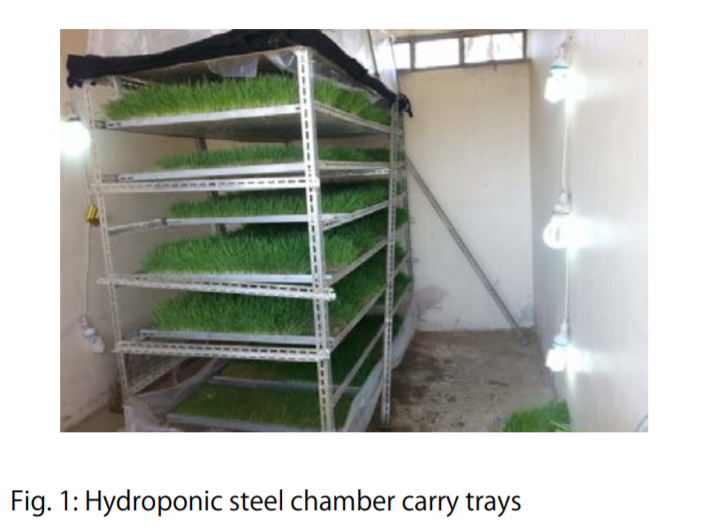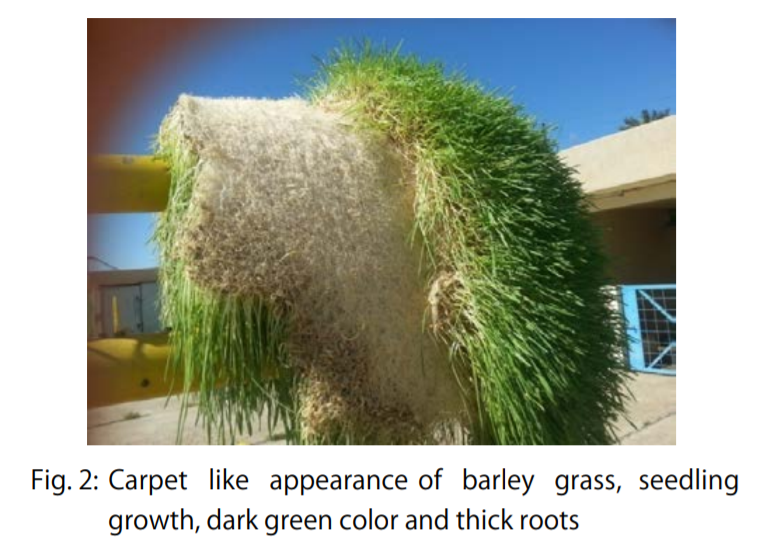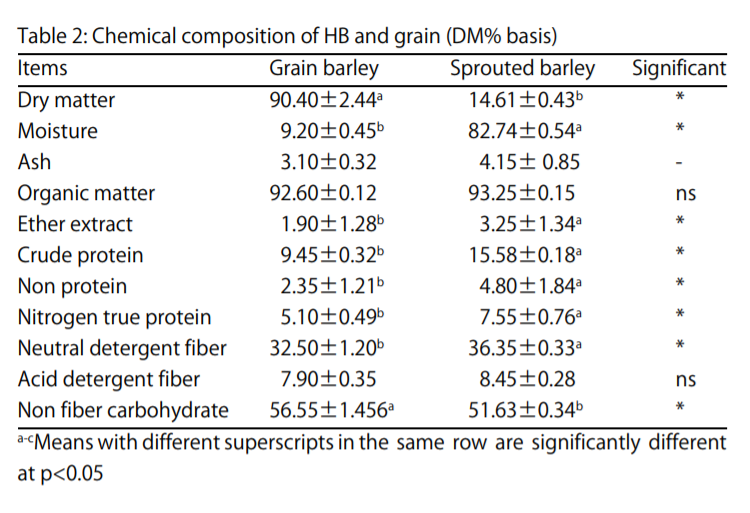Productive Effects and Economical Feasibility
According to the results, it could be recommended to substituted more sprouted barley than used in the present study to the diet of ruminants and lambs for more economic profit and to improvement productive traits.
Productive Effects and Economical Feasibility of Substituting Barley by 10% and 30% with Sprouted Barley in the Diet of Male Awassi Lambs
M.J. AL-Saadi
Department of Hygiene, College of Veterinary Medicine, University of Baghdad, Baghdad, Iraq
Abstract
Materials and Methods: The production plan was designed for 120 days period, using hydroponic steel chamber. Barley seeds were cleaned, washed, soaked and spread on the trays in order to implantation by hydroponic system and water irrigation, lambs is with average body weight of 19.25±0.25 kg and 4 month ages was split into 3 groups, 6 to each. All groups were daily feed with 2% b.wt., of concentrate diet, the amount of feed daily recorded, dry matter intake and feed conversion ratio calculated by weekly. Body weight also, biweekly recorded. One way ANOVA test were conducted to compare the means of each treatment, data were analyzed by using SPSS statistical.
Results: The chemical analysis revealed significantly higher value in barley grains in comparative to sprouts, but in organic matter and acid detergent fiber chemical analysis values were appeared non-significantly, in blood parameters evaluation, both treated groups particularly 30% group recorded higher values compare to control group. In productive trail the total concentrate diet consumed by each animal in different groups were 63.00, 68.760 and 59.04 kg for groups 10 and 30% and control, the amount of concentrate diet consumed by each animals without sprouts in different groups were 60.48, 60.48 and 59.04, respectively, while the total amount of the sprouts in treated groups were 2.520 and 8.28 kg, then, the total price are 132.96, 192.24 and 96.96 in Iraqi Dinar/1000, thus the total profit for each group are 84.68, 141.96 and 61.51 Iraqi Dinar/1000 for 10 and 30% and control group, respectively.
Conclusion: According to these results it could be recommend to substituted more high than present percentages of sprouted barley those used in present study to the diet of ruminants and lambs for more economic profit and to improvements productive traits.
Published: August 15, 2016
Citation: M.J. AL-Saadi, 2016. Productive effects and economical feasibility of substitution barley by 10 and 30% of sprouted barley in diet of male lambs. Asian J. Anim. Vet. Adv., 11: 563-569.
Corresponding Author: M.J. AL-Saadi, Department of Hygiene, College of Veterinary Medicine, University of Baghdad, Baghdad, Iraq
Copyright: © 2016 M.J. AL-Saadi. This is an open access article distributed under the terms of the creative commons attribution License, which permits unrestricted use, distribution and reproduction in any medium, provided the original author and source are credited.
Competing Interest: The author has declared that no competing interest exists.
Introduction
Materials and Methods



Results and Discussion


Group (30%) vs Control Group
- Increased Average Weight 28%
- Increased Total Body Gain 98%
- Increased Average Daily Gain 98%
- Increased Feed Conversion Effeciency 70%


Conclusion
Acknowledgements
References
- Sneath, R. and F. McIntosh, 2003. Review of hydroponic fodder production for beef cattle. Project No. NBP. 332, Meat and Livestock Australia Limited, October 2003, Australia, pp: 54.
- Al-Karaki, G.N. and M. Al-Hashimi, 2012. Green fodder production and water use efficiency of some forage crops under hydroponic conditions. ISRN Agron. 10.5402/2012/924672.
- New Zealand Merino Co., 2011. Hydroponic fodder production: An analysis of the practicaland commercial opportunity. The New Zealand Merino Company, October 2011, pp: 1-18.
- Al-Saadi, M.J. and I.A.H. Al-Zubiadi, 2016. Effects of substitution barley by 10%, 30% of sprouted barley on rumen characters, digestibility and feed efficiency in diet of awassi male lambs. Int. J. Sci. Res., 5: 2228-2233.
- Finney, P.L., 1983. Effect of germination on cereal and legume nutrient changes and food or feed value: A comprehensive review. Recent Adv. Phytochem., 17: 229-305.
- Grigorev, N.G., A.I. Fistev and I. Lesnitskaya, 1986. Nutritive value of hydroponic feed and its use for feeding high-yielding cows. Selskokhozyaistvennaya Biol., 7: 47-50.
- Tudor, G., T. Darcy, P. Smith and F. Shallcross, 2003. The intake and liveweight change of droughtmaster steers fed hydroponically grown, young sprouted barley fodder (Autograss). Department of Agriculture Western Australia.
- Thomas, T.A., 1977. An automated procedure for the determination of soluble carbohydrates in herbage. J. Sci. Food Agric., 28: 639-642.
- Omar, J.M.A., R. Daya and A. Ghaleb, 2012. Effects of different forms of olive cake on the performance and carcass quality of Awassi lambs. Anim. Feed Sci. Technol., 171: 167-172.
- Peer, D.J. and S. Leeson, 1985. Feeding value of hydroponically sprouted barley for poultry and pigs. Anim. Feed Sci. Technol., 13: 183-190.
- PCPS., 2010. The annual bulletin. Palestinian Central Bureau of Statistics, State of Palestine.
- AOAC., 1999. Official Methods of Analysis. 16th Edn., Association of Official Analytical Chemists, Arlington, Virginia, USA.
- AOAC., 1995. Official Methods of Analysis. 6th Edn., Association of Official Analytical Chemists, Washington, DC., USA.
- Henry, R.J., 1965. Clinical Chemistry: Principles and Techniques. Harper and Row, Publishers, PA., Pages: 293.
- Armstrong, W.D. and C.W. Carr, 1964. Physiological Chemistry. 3rd Edn., Laboratory Directions Bures Publishing Co., Minneapolis Minnesota USA.
- Doumas, B.T., W.A. Watson and H.G. Biggs, 1971. Albumin standards and the measurement of serum albumin with bromcresol green. Clinica Chimica Acta, 31: 87-96.
- Patton, C.J. and S.R. Crouch, 1977. Enzymatic colorimetric method to determination urea in serum. Anal. Chem., 49: 464-464.
- Snedecor, G.W. and W.G. Cochran, 1973. Statistical Methods. 6th Edn., The Iowa State University Press, Ames, IA.
- Dung, D.D., I.R. Godwin and J.V. Nolan, 2010. Nutrient content and in sacco digestibility of barley grain and sprouted barley. J. Anim. Vet. Adv., 9: 2485-2492.
- Fayed, A.M., 2011. Comparative study and feed evaluation of sprouted barley grains on rice straw versus Tamarix mannifera on performance of growing Barki lambs in Sinai. J. Am. Sci., 7: 954-961.
- Fazaeli, H., H.A. Golmohammadi, S.N. Tabatabayee and M. Asghari-Tabrizi, 2012. Productivity and nutritive value of barley green fodder yield in hydroponic system. World Applied Sci., 16: 531-539.
- Naik, P.K., R.B. Dhuri, M. Karunakaran, B.K. Swain and N.P. Singh, 2013. Hydroponics technology for green fodder production. Indian Dairyman, 65: 54-58.
- Naik, P.K., R.B. Dhuri, M. Karunakaran, B.K. Swain and N.P. Singh, 2014. Effect of feeding hydroponics maize fodder on digestibility of nutrients and milk production in lactating cows. Indian J. Anim. Sci., 84: 880-883.
- Fazaeli, H., H.A. Golmohammadi, A.A. Shoayee, N. Montajebi and S. Mosharraf, 2011. Performance of feedlot calves fed hydroponics fodder barley. J. Agric. Sci. Tech., 13: 367-375.
- Dung, D.D., I.R. Godwin and J.V. Nolan, 2010. Nutrient content and in sacco degradation of hydroponic barley sprouts grown using nutrient solution or tap water. J. Anim. Vet. Adv., 9: 2432-2436.
- Naik, P.K., R.B. Dhuri, B.K. Swain and N.P. Singh, 2013. Water management for green fodder production livestock feed in Goa. Proceedings of the International Conference on Water Management for Climate Resilient Agriculture, May 28-31, 2013, Maharashtra, India, pp: 126-127.
- Kumar, N., U.B. Singh and D.N. Verma, 1981. Effect of different levels of dietary protein and energy on growth of male buffalo calves. Indian J. Anim. Sci., 51: 513-517.
- Ibrahim, A.F., M.H. Hoda and I.M. El-Sayed, 2001. Effect of using sprouted barley by recycle process of agriculture residues on feeding value, rumen activity and some blood constituents of crossbred sheep. Egypt. J. Nutr. Feeds, 4: 265-273.
- Chavan, J.K., S.S. Kadam and L.R. Beuchat, 1989. Nutritional improvement of cereals by sprouting. Crit. Rev. Food Sci. Nutr., 28: 401-437.
- Shipard, I., 2005. How Can I Grow and Use Sprouts as Living Food? 2nd Edn., David Stewart, Hershey, PA., ISBN-13: 9780975825204, Pages: 136.
- Shewry, P.R., 2007. Improving the protein content and composition of cereal grain. J. Cereal Sci., 46: 239-250.
- MacLeod, A.M. and H.B. White, 1962. Lipid metabolism in germinating barley. II. Barley lipase. J. Inst. Brewing, 68: 487-495.
- Baker, J.F., R.C. Vann and W.E. Neville Jr., 2002. Evaluations of genotype x environment interactions of beef bulls performance-tested in feedlot or pasture. J. Anim. Sci., 80: 1716-1724.
- Restle, J., M. Neumann, I.L. Brondani, J.M. Goncalves and L.G. de Pellegrini, 2003. Evaluation of alexander grass silage (Brachiaria plantaginea) through feedlot performance of beef calves. Ciencia Rural, 33: 749-756.
- Berry, B.A., C.R. Krehbiel, A.W. Confer, D.R. Gill, R.A. Smith and M. Montelongo, 2004. Effects of dietary energy and starch concentrations for newly received feedlot calves: I. Growth performance and health. J. Anim. Sci., 82: 837-844.
- Rajendra, P., J.P. Sehgal, B.C. Patnayak and R.K. Beniwal, 1998. Utilization of artificially grown barley fodder by sheep. Indian J. Small Rumin., 4: 63-68.
- Mayer, A.M. and A. Poljakoff-Mayber, 1975. The Germination of Seeds. 2nd Edn., Pergamon Press, New York.
- Kruglyakov, Y.A., 1989. Construction of equipment for growing green fodder by a hydroponic technique. Traktory-I Sel’skokhozyaistvennye Mashiny, 6: 24-27.
- Farlin, S.D., J.J. Dahmen and T.D. Bell, 1971. Effect of sprouting on nutritional value of wheat in cattle diets. Can. J. Anim. Sci., 51: 147-151.
- Leitch, I., 1939. Sprouted Fodder and Germinated Grain in Stock Feeding. Imprint Unknown, New York, USA., ISBN-13: 978-0851981352, Pages: 63.
- Myers, J., 1974. Feeding livestock from the hydroponic garden. M.Sc. Thesis, Arizona State University.
- Naik, P.K., S.P. Gaikwad, M.J. Gupta, R.B. Dhuri, G.M. Dhumal and N.P. Singh, 2013. Low cost devices for hydroponics fodder production. Indian Dairyman, 65: 68-72.
- Gebremedhin, W.K., 2015. Nutritional benefit and economic value of feeding hydroponically grown maize and barley fodder for Konkan Kanyal goats. IOSR J. Agric. Vet. Sci., 8: 24-30.
- Hassan, G.H. and M.H. Mona, 2013. Sprouted zea mays on date palm leaves and potatoes peel waste mixture and its effects on performance of desert goats under dry season in Sinai. Desert Research Center, Mataria, Cairo, Egypt.
- Ata, M., 2016. Effect of hydroponic barley fodder on awassi lambs performance. J. Biol. Agric. Healthcare, 6: 2224-2234.
- Saidi, A.R.M.A. and J.A. Omar, 2015. The biological and economical feasibility of feeding barley green fodder to lactating awassi ewes. Open J. Anim. Sci., 5: 99-105.
Want to know more?
As one of the world’s leading manufacturers of vertical farming technology, we’d love to empower you to grow food for your community.
